 Index
Index

Shinji Imahori [profile]
Artistic Tiling
Shinji Imahori
Professor, Faculty of Science and Engineering, Chuo University
Areas of Specialization: Combinatorial optimization and Mathematical informatics
Introduction
What do you think of when you hear tiling or tiles? Many people may be familiar with orderly rows of square or rectangular tiles in a bathroom or kitchen. In fact, there is a variety of free-shaped tiling around us. For example, tiling began as art to decorate the floors, walls and ceilings of buildings in ancient Rome or Arabic culture. Even now, you can see the tiling art works in Alhambra Palace in Spain. Meanwhile, in recent years, a Dutch artist, Escher, presented many tiling works using complicated forms of tiles such as animals and plants, and tiling is now receiving attention as a new way of art expression. Here, I would like to introduce the artistic works of tiling.
What is tiling?
Let me share the definition of tiling.
Tiling: A style in which one and the same shape of figure (called tiles) are regularly paved on a flat surface without a space or overlap
Tilings are made by more than 2 types of figures, which is used to cover non-flat surfaces (for example, a soccer ball has a spherical surface filled by regular pentagons and regular hexagons). But let’s take a look at other examples. What kind of regular tilings are made by one type of figure? People may only think of a very simple tiling. In fact, for the regular polygon (polygon that has the same length of sides and same angles between sides) tiling, the shapes of tiles are limited to a regular triangle, a square and a regular hexagon. However, without limiting to regular polygons, there are tilings made by pentagons (for example, the shape of a home base in baseball is a tile that can fill the plain surface), heptagon, octagon, and so on. Actually, there are unlimited figures of tiles that can fill a plain surface.
Escher-style tiling
Now, let’s talk about “artistic” tilings that are the subject of this paper. Have you heard of Escher? Escher is a Dutch painter (print maker) in the 20th century. He drew optical illusions (trompe l'oeil) that were possible on paper but impossible to construct. He also created many mystical and unique art works using complicated shapes of tiles such as animals and plants. For those of you who have never seen his works or seen only few of his works, I encourage you to go to his official web site (http://www.mcescher.com/![]() ). You can also see many wonderful works of Escher and other artists’ works related to Escher’s works when you do a search on the internet.
). You can also see many wonderful works of Escher and other artists’ works related to Escher’s works when you do a search on the internet.
Studying Escher’s works (tiling work in this paper) may tempt you to draw similar pictures, but you may give up after realizing that such works require extraordinary artistic sense and efforts that cannot be attained by ordinary people. However, the methods to create various types of tilings are actually systematized, and by learning the technique, anyone can create tiling works using complicated shapes of tiles. Furthermore, using the algorithm I will introduce in the next section you can generate not only tiling with complicated shapes of tiles but also tiling using your own favorite shapes.
Tiling generation algorithm
I would like to introduce a method to generate a tiling work using complicated free-style shapes like the works of Escher. The standard tiling method is, first, to fill the plain surface using tiles of a basic shape (e.g. triangle or tetragon) and then modify the shape of the tiles little by little (for details, please see references below). If you have an artistic sense, you can create a great tiling work through trial and error. Unfortunately, I did not have any artistic sense. Therefore, I created tiling works like the works of Escher using optimization and algorithm.
The first step is to draw a picture. It can be any picture such as a dog, cat or fish. Let’s call this picture Figure S. It would sound difficult to try to draw a figure for tiling, but drawing just a picture of dog, cat or fish should not be difficult. If Figure S is a tile, or in other words, if you can fill a plain surface using Figure S without a space and overlap, you can create a great tiling work. However, in reality this is more like a miracle and will not happen as easily as it sounds. So, we need to solve the problem of finding Figure T that fulfills the following two conditions: given Figure S, “Figure T needs to be able to fill the plain surface” and “Figure T needs to be similar to Figure S as much as possible”. Finding an answer to achieve a purpose (Figure T needs to be similar to Figure S as much as possible) under the restrictive condition (Figure T needs to be able to fill a plain surface) is called an optimization problem. If we can find Figure T which is shaped close enough to Figure S that was drawn in the beginning, we should end up with a great outcome. The question is, how can we achieve this?
My area of specialization is designing combinatorial optimization algorithms (how to solve problems), and I developed an algorithm to generate Escher-style tiling. We developed a program to obtain Tile T, given Figure S, instead of manually creating an artistic tiling. I will not explain the details of the algorithm here. Briefly, we can obtain Tile T that has the closest shape by inputting Figure S through a calculation of matrix eigenvalue and eigenvector that you learn in linear algebra class. I would be happy if you can take a look at the tiling we created using the Escher-style tiling generation algorithm that we developed and enjoy the art of tiling.
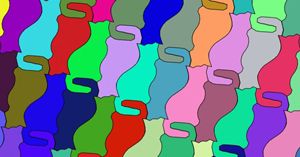
Cat
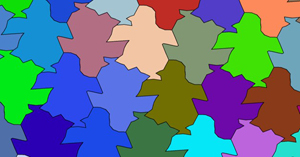
Penguin

Sea horse
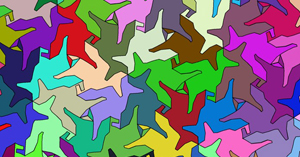
Pegasus
Conclusion
This paper focused on using tiles to fill a plain surface without a space or overlap, and introduced a method to create a tiling like the one made by Escher. Lastly, I would like to briefly mention two more topics concerning tiling that I could not cover above.
Discovery of new tiling with convex pentagons: I mentioned earlier that plain surface can be filled by pentagon-shaped tiles. The tilings by convex pentagon-shaped tiles have been classified since the beginning of the 20th century. In 1985, 14 kinds of tilings were discovered, and there had been no new discovery for 30 years since then; however, 15 kinds of tilings were identified through a search using a computer in August this year. Whether new types of tiling can be found or not in the future is the center of attention.
Tilings using 2 types of figures: As seen in the works of Escher, tiling using multiple kinds of figures is another interesting research subject. I will not explain the details of the development process here, but will show 2 tiling works that were designed by us using a computer. There are also many tiling works for which figures are lined up irregularly (aperiodic) instead of regularly. The well-known work for such aperiodic tilings is called Penrose tiling. As much as it is interesting from a mathematical perspective, it also has a deep connection with a new substance called quasi-crystal, and further development of research on this topic is expected.
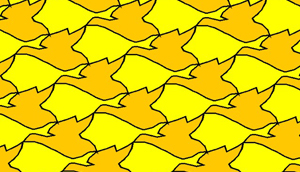
Bird and fish
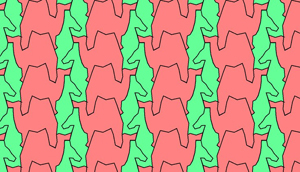
Seahorse and camel
References
- Kokichi Sugihara, “Basic Technique of Tiling Painting Method” (Seibundo Shinkosha, 2009)
- Shinji Imahori
Professor, Faculty of Science and Engineering, Chuo University
Areas of Specialization: Combinatorial optimization and Mathematical informatics - Shinji Imahori was born in Aichi prefecture in 1976. After graduating from the Faculty of Engineering at Kyoto University in 1999, he completed the Master Program at Graduate School of Informatics, Kyoto University in 2001.
He completed the Doctoral Program of Graduate School of Informatics, Kyoto University in 2004. He obtained a Ph.D. in Informatics from Kyoto University.
After working as a special research fellow, teaching assistant, and then assistant professor at Graduate School of Information Science and Technology, the University of Tokyo, he worked as a lecturer and later associate professor at Graduate School of Engineering, Nagoya University. In 2015, he assumed the current position.
His current research theme is to establish practical algorithms that can be used to solve various issues in the everyday world (specifically, combinatorial optimization problem algorithms such as figure arrangement, scheduling, and path design) from a mathematical point of view.
- Research Activities as a Member of Research Fellowship for Young Scientists (DC1), Japan Society for the Promotion of Science (JSPS) Shuma Tsurumi
- Important Factors for Innovation in Payment Services Nobuhiko Sugiura
- Beyond the Concepts of Fellow Citizens and Foreigners— To Achieve SDGs Goal 10 “Reduce Inequality Within and Among Countries” Rika Lee
- Diary of Struggles in Cambodia Fumie Fukuoka
- How Can We Measure Learning Ability?
—Analysis of a Competency Self-Assessment Questionnaire— Yu Saito / Yoko Neha - The Making of the Movie Kirakira Megane








